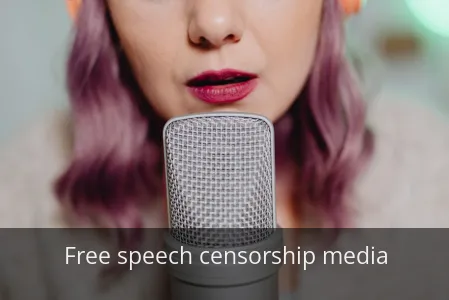
Ever scroll through your feed and feel like you’ve stumbled into a digital minefield where the rules of conversation are constantly shifting?
You’re not alone.
The line between protecting the public and policing thought has become the defining battle of our information age, and the media giants are the ones drawing the maps.
In this article, we’ll dive into three explosive instances where major platforms were accused of crossing a red line, exploring the fierce debate from both sides.
By the end, you’ll have the facts to decide for yourself: responsible moderation or dangerous censorship?
The Hunter Biden Laptop Blackout: Election Interference or Prudent Caution?

Weeks before the 2020 presidential election, the New York Post dropped a bombshell story based on data from a laptop allegedly belonging to Hunter Biden.
Then, something just as shocking happened: the story was virtually disappeared.
Twitter swiftly locked the Post’s account and prevented users from sharing the link, citing their ‘hacked materials’ policy.
Facebook also drastically limited the story’s distribution, stating it needed to be fact-checked by their third-party partners.
The backlash from conservatives and free speech advocates was immediate and furious.
They accused the tech titans of blatant election interference and acting as an arm of the Democratic Party, suppressing a story that could have swayed voters.
For them, it was a crystal-clear case of Silicon Valley picking a side.
On the other side of the argument, the platforms defended their actions as a necessary firewall against potential misinformation.
They pointed to the dubious origins of the laptop and the looming threat of foreign disinformation campaigns, arguing that caution was paramount so close to an election.
Was this a responsible move to protect the integrity of the democratic process, or the most powerful form of censorship—making a story vanish before it could even be debated?
The Deplatforming of a President: Protecting the Public or a Digital Coup?

You likely won’t believe the sheer scale of this one.
Following the January 6th Capitol riot, a sitting President of the United States was effectively erased from mainstream social media.
In an unprecedented coordinated effort, Twitter permanently banned Donald Trump, while Facebook and YouTube issued indefinite suspensions.
The companies stated that his posts constituted “incitement to violence” and that the risk of further harm was too great.
Proponents of the bans cheered, calling it a long-overdue enforcement of terms of service against a user who had repeatedly flouted them.
They argued that free speech doesn’t include the right to amplify messages that can lead to real-world violence and insurrection.
For them, it was about safety, not politics.
Critics, however, saw it as a terrifying consolidation of power.
They argued that a small group of corporate CEOs had made the decision to silence the most powerful political voice in the country, setting a dangerous precedent for who gets to control public discourse.
If they can silence a president, the thinking goes, who’s next?
This wasn’t moderation; it was a digital excommunication that forever changed the relationship between power and platform.
The “Shadowbanning” Saga: Algorithmic Censorship or Just Bad Engagement?

This third line is the most insidious because it’s often invisible.
“Shadowbanning” refers to the alleged practice of limiting a user’s or post’s reach without their knowledge.
Their content doesn’t get deleted; it just gets hidden from everyone else’s feeds and search results, effectively muting them into obscurity.
Accusations of this covert censorship have flown for years, often targeting conservative and alternative voices.
Those who believe it exists point to mysterious drops in engagement, verified user testimonies, and leaked internal documents discussing “visibility filtering.”
They argue it’s a cowardly way to suppress controversial ideas without the backlash of an outright ban, making it the perfect form of plausible deniability censorship.
The platforms, for their part, consistently deny intentionally shadowbanning users based on ideology.
They attribute changes in reach to neutral algorithms that demote spam, low-quality content, or posts that violate community guidelines.
It’s not censorship, they claim, it’s curation designed to improve the user experience for everyone.
So, is it a deliberate silencing campaign, or are we just blaming the algorithm for our bad takes not getting likes?
Where Do You Draw the Line?
These three cases reveal a landscape with no easy answers.
Is it a platform’s right—or even its responsibility—to deamplify content it deems harmful?
Or does that power inevitably corrupt, creating a digital oligarchy that dictates the boundaries of acceptable speech?
The truth likely lies somewhere in the messy, uncomfortable middle.
One person’s “common-sense moderation” is another’s “unconscionable censorship.”
The most important question isn’t what Twitter or Facebook thinks; it’s what you think.
Where does your line begin?
Your Eyes on the Digital Frontline

After hours of scrolling through heated debates and absorbing contentious content, have you ever felt that pounding headache or the gritty, tired sensation behind your eyes?
This physical toll is the often-overlooked consequence of engaging with modern media, a direct result of the harsh blue light emitted by our screens.
It is a peculiar irony that the very devices granting us access to the world’s conversations can also make participating in them a literal pain.
So, how do we protect our most valuable tools for perception without disconnecting from the vital discourse?
The answer might be simpler than you think.
Consider a pair of high-quality Blue Light Blocking Glasses as essential armor for the digital citizen.
They work by filtering out the high-energy visible light that contributes to digital eye strain, headaches, and even disrupted sleep.
Imagine being able to dive into a lengthy editorial or a vibrant comment thread and emerge feeling clear-headed and focused, not fatigued.
For a superior experience, many dedicated readers and professionals are turning to Gamma Ray Blue Light Blocking Glasses.
Their advanced lenses are specifically engineered to combat the glare from LEDs and monitors, offering a tangible solution for endless scrolling.
This isn’t just about comfort; it’s about enabling you to stay informed and engaged for longer, without the physical discomfort.
Because protecting your right to speak and listen also means protecting your ability to see the screen clearly.

Leave a Reply